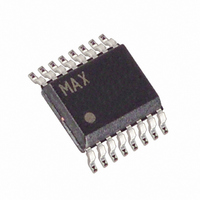MAX1809EEE+T Maxim Integrated Products, MAX1809EEE+T Datasheet - Page 12

MAX1809EEE+T
Manufacturer Part Number
MAX1809EEE+T
Description
IC DDR TERMINATION 16-QSOP
Manufacturer
Maxim Integrated Products
Datasheet
1.MAX1809EEE.pdf
(17 pages)
Specifications of MAX1809EEE+T
Applications
Converter, DDR
Voltage - Input
3 ~ 5.5 V
Number Of Outputs
1
Voltage - Output
1.1 ~ 5.5 V
Operating Temperature
0°C ~ 85°C
Mounting Type
Surface Mount
Package / Case
16-QSOP
Lead Free Status / RoHS Status
Lead free / RoHS Compliant
3A, 1MHz, DDR Memory Termination Supply
output regulates at a slightly lower voltage under a
given load, allowing more voltage headroom as the
load changes suddenly to zero or to the opposite polarity
(sinking mode). By utilizing the full-voltage tolerance lim-
its, the total output capacitance can be reduced and the
capacitor’s ESR can be increased.
Choose R
maximum load current, including ripple, is just above
the lower limit of the output tolerance.
Voltage positioning results in some loss in efficiency
due to the power dissipated in R
power loss is given by R
must be able to handle this power.
Ceramic capacitors have advantages and disadvan-
tages. They have ultra-low ESR and are noncom-
bustible, relatively small, and nonpolarized. They are
also expensive and brittle, and their ultra-low ESR char-
acteristic can result in excessively low output-voltage
ripple (affecting stability in nonvoltage-positioned cir-
cuits). In addition, their relatively low capacitance value
can cause output overshoot when going abruptly from
full-load sourcing to full-load sinking conditions, unless
the inductor value can be made small (high switching
frequency), or there are some bulk tantalum or elec-
trolytic capacitors in parallel to absorb the stored energy
in the inductor. In some cases, there may be no room for
electrolytics, creating a need for a DC-DC design that
uses nothing but ceramics.
The MAX1809 can take full advantage of the small size
and low ESR of ceramic output capacitors in a voltage-
positioned circuit. The addition of the positioning resis-
tor increases the ripple at FB, satisfying the minimum
feedback ripple voltage requirement.
Output overshoot (V
output capacitance requirement (see the Output
Capacitor Selection). Often the switching frequency is set
as high as possible (near 1000kHz), and the inductor
value is reduced to minimize the energy transferred from
inductor to capacitor during load-step recovery.
The output of the MAX1809 can accept current due to
the reversible properties of the buck and the boost con-
verter. When voltage at the output of the MAX1809
(low-voltage port) exceeds or equals the output set
voltage the flow of energy reverses, going from the out-
put to the input (high-voltage port). If the input (high-
voltage port) is not connected to a low-impedance
12
R
______________________________________________________________________________________
Ceramic Output Capacitor Applications
DROOP
DROOP
✕
I
OUT(MAX)
such that the output voltage at the
(V
SOAR
RIPPLE
DROOP
≤ V
) determines the minimum
OUT(TYP)
/ 2)
✕
DROOP
I
OUT(MAX)
- V
Input Source
. The maximum
OUT(MIN)
2
. R
DROOP
-
source capable of absorbing energy, the voltage at the
input will rise. This voltage can violate the absolute maxi-
mum voltage at the input of the MAX1809 and destroy
the part. This occurs when sinking current because the
topology acts as a boost converter, pumping energy
from the low-voltage side (the output), to the high-voltage
side (the input). The input (high-voltage side) voltage is
limited only by the clamping effect of the voltage source
connected there. To avoid this problem, make sure the
input to the MAX1809 is connected to a low impedance,
two quadrant supply or that the load (excluding the
MAX1809) connected to that supply consumes more
power than the amount being transferred from the
MAX1809 output to the input.
DDR memory architecture is a high-speed system that
clocks data on both the rising and falling edges of the
clock. This increases the data rate, and at the same
time increases the system power dissipation. High-
speed digital logic requires termination of the buses to
minimize ringing and reflection. Using an active termi-
nation scheme reduces the power dissipation of the
bus. By connecting the termination resistors to a supply
voltage (V
Figure 7. Soft-Start Current Limit Over Time
Figure 8. Active Bus Termination
I
LIMIT
V
SS
SHDN
(V)
(A)
V
DDQ
0
0
0
TT
) that is half the memory voltage (V
(MAX1809)
V
OUT
Active Bus Termination
0.7V
+
-
V
COMMON BUS
TERMINATION RESISTOR
DDQ
LINE RECEIVERS
/2 = V
TT
t
1.8V
I
LIMIT
DDQ
),








